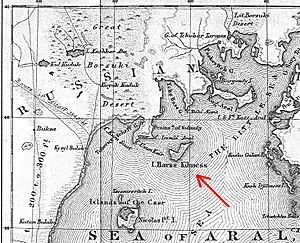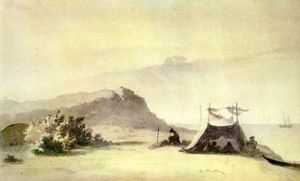Barsa-Kelmes


Barsa-Kelmes (from Kazakh: "the land of no return") was the largest island in the Aral Sea which encompasses the Barsa-Kelmes Nature Reserve. Its area was 133 km2 in the 1980s, but has been steadily growing due to shallowing of the sea, until in the 1990s it ceased to be an island. Its altitude reaches up to 113 m. Because of the native salt deposits it is recommended to close the eyes during dust storms and strong winds.
History
The first recorded survey of the island was made in August, 1848 when Geographer A. Maksheyev and topographer A. Akishev made a topographical survey of the island and described its landscape. The first sketches of the local nature have been made by Taras Shevchenko.
A jumping spider Sitticus barsakelmes was named after the island in 1998.
Urban legend
During the second half of the 20th century, there was a persistent urban legend about some paranormal phenomena occurring on the island. The legend reached its peak in early 1990s, when popular science magazine Tekhnika Molodyozhi published a large article about these phenomena, listing local medical student Sergey Lukyanenko as their chief source.[1][2] It told an engaging story of variable flow of time on the island, possible UFO visitation, and featured a numerous letters and stories from local fishermen about strange temporal variations, disappearing expeditions etc.[1]
It was later revealed, however, that all these legends were in fact a series of elaborate hoaxes, perpetrated by several successive generations of local writers and journalists for their own amusement, that central publications believed and picked up to boost the public interest.[3][4] The persons who outed the hoax were no other than aforementioned Sergey Lukyanenko, one of the main perpetrators of the hoax who later went to become the most popular Russian SciFi writer,[4] and Grigory Neverov, then president of KLF MGU (KLF = kluba lyubiteley fantastiki, club of fantasy fans), whose involvement started it all.[3]
As the story went, when Neverov asked his colleagues over all USSR whether they could remember any stories about some paranormal phenomena in their regions, Lukyanenko, then an active member in the Alma-Ata KLF, remembered some rumors about mysterious doings on Barsa-Kelmes and decided to play a practical joke on the hapless Moscow fellow. He found the origin of those rumors, an old story in a local newspaper, together with his friends fabricated the evidences like the fishermen letters, and even invented a local version of a Kazakh epic about hero Koblandy-batyr.[3] Neverov bought into a story and reported it to the TM editorial staff that published the aforementioned article. Later, when Lukyanenko admitted a hoax to Neverov, they tried to trace down the origin of the article that inspired the joke, and found that it itself was a joke by a local journalist.[3] However, despite debunking of the myth, it remains pretty much alive and often surfaces in Russian publications catering to the paranormal crowd.[5]
References
- ↑ 1.0 1.1 Tekhnika Molodyozhi (Техника молодежи), 1991, No. 3;
- ↑ Tekhnika Molodyozhi 1993, No. 4.
- ↑ 3.0 3.1 3.2 3.3 ""The real mystery of Barsa-Kelmes island, or how it was in fact (an attempt in investigation)", Informational Bulletin". MGU SciFi fan club, Issue 9.
- ↑ 4.0 4.1 "Koblandy-batyr and Barsa-Kelmes". Sergey Lukyanenko.
- ↑ Encyclopaedia of the mysterious places on Earth ( Энциклопедия загадочных мест земли).
External links
Coordinates: 45°38′N 59°52′E / 45.633°N 59.867°E